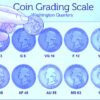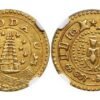Numismatic Grading: Understanding the Coin Grading Scale
Numismatic grading is a crucial aspect of coin collecting, as it determines a coin’s condition, rarity, and ultimately its value. As a collector, understanding the coin grading scale is essential for making informed decisions when buying or selling coins. In this article, we will delve into the world of numismatic grading, demystifying the grading scale and explaining how each grade affects a coin’s desirability and market price.
The Importance of Coin Grading: Explain the significance of coin grading in the numismatic community. Grading provides a standardized method to assess a coin’s condition, taking into account factors like wear, damage, and overall preservation. A well-graded coin can significantly impact its value, making grading a vital skill for collectors and investors.
The Sheldon Coin Grading Scale: Introduce the Sheldon Coin Grading Scale, the most widely used system in the numismatic world. Explain how the scale ranges from 1 to 70, with each grade representing a specific level of wear or condition. Provide a brief overview of the primary grades, from “Poor” to “Mint State” (Uncirculated), and describe the criteria that determine each grade.
Identifying Grades: Key Characteristics: Detail the key characteristics that numismatists look for when grading coins. Include elements like luster, surface preservation, strike quality, and wear patterns. Use side-by-side comparisons of coins at different grades to help readers visualize these characteristics.
Grading Circulated Coins: Discuss the nuances of grading circulated coins, which are coins that have been used in everyday transactions. Explain how wear due to handling and circulation impacts the grading process. Use examples of coins at different circulated grades to illustrate the variations in appearance.
Grading Uncirculated Coins: Explain the grading process for Uncirculated coins, which have not seen any circulation and are often in pristine condition. Detail the criteria for determining the various Mint State (MS) grades, from MS-60 to MS-70, and describe the importance of eye appeal for higher grades.
The Influence of Grading on Coin Value: Highlight the direct correlation between coin grade and market value. Discuss how even a slight difference in grade can lead to significant differences in price, particularly for rare coins. Share examples of how coins with higher grades command premium prices at auctions and in the collector’s market.
Conclusion: Understanding the coin grading scale is an indispensable skill for any serious coin collector or investor. Grading allows collectors to objectively assess a coin’s condition, rarity, and value, making informed decisions when buying, selling, or adding to their collections. As you delve deeper into the world of numismatics, mastering coin grading will enhance your appreciation for the artistry and historical significance of each coin, turning your collection into a treasure trove of graded numismatic gems.
Recent Posts
Social Media
Subscribe to our newsletter and enjoy a 2% discount!
Subscribe for news on new products, sales, and more!
Sign up now to receive the latest updates on promotions and coupons. Rest assured, we do not send spam!
Support
Social Media
Copyright 2024 © YGM Collections. All right reserved





